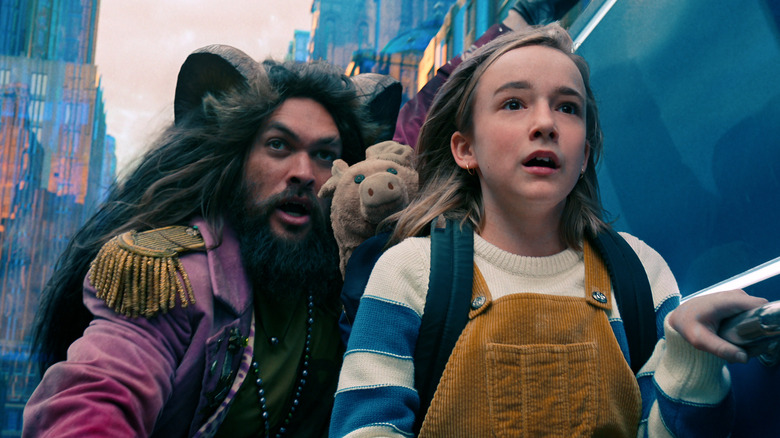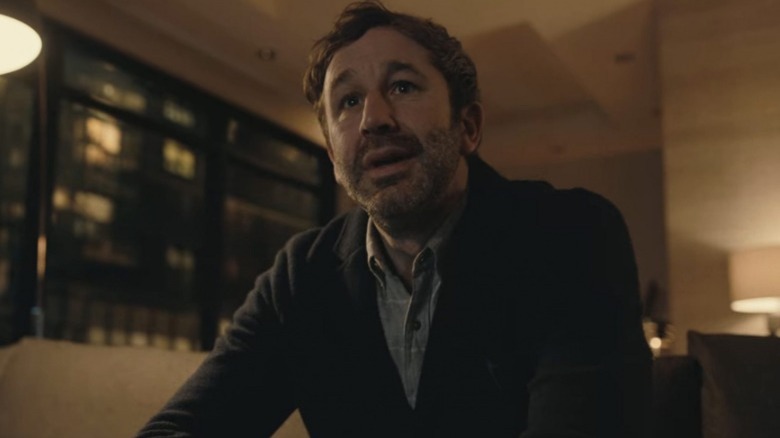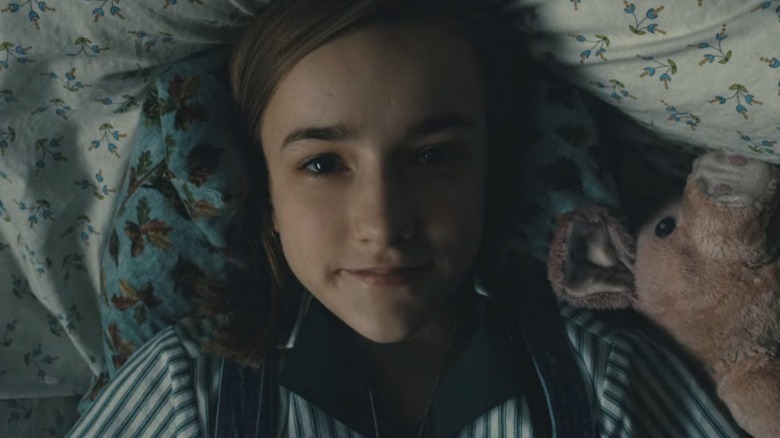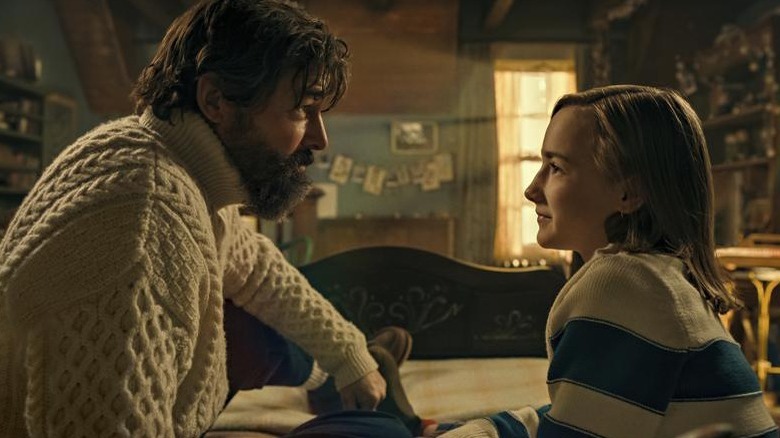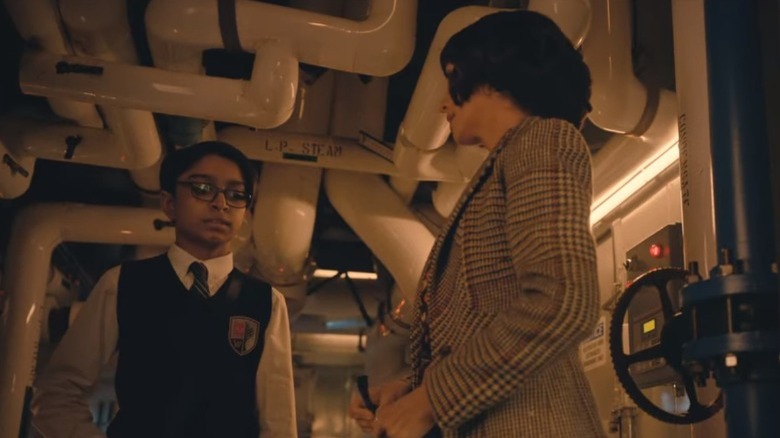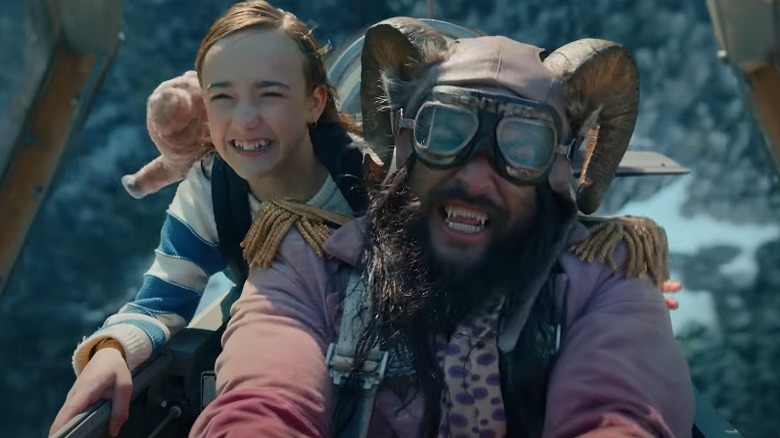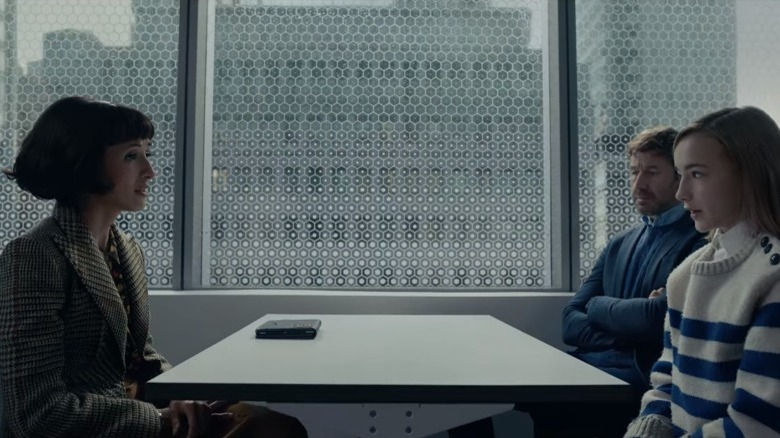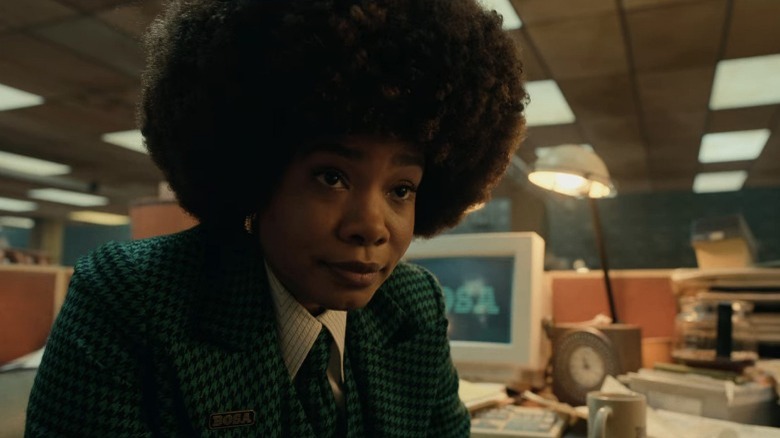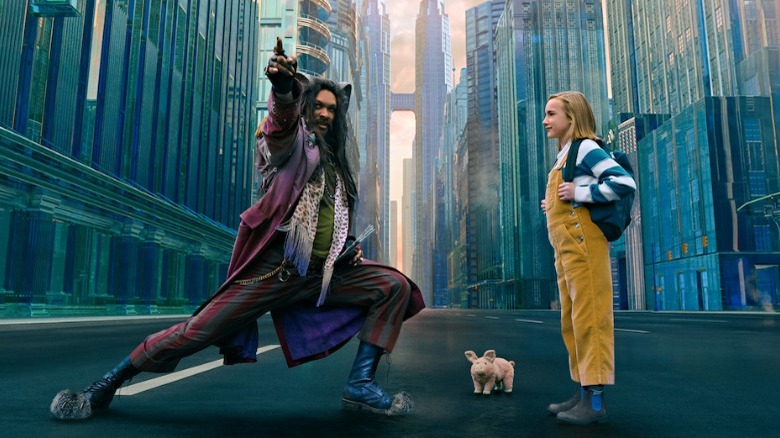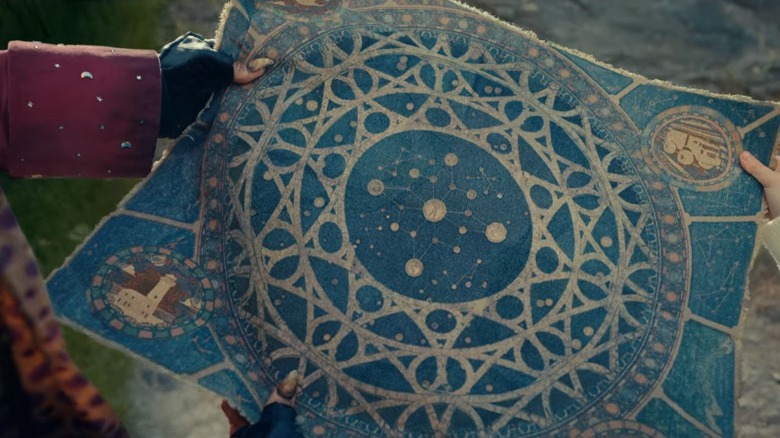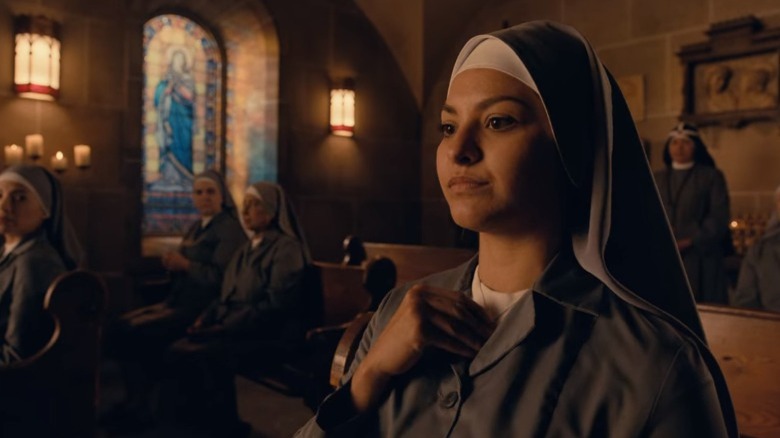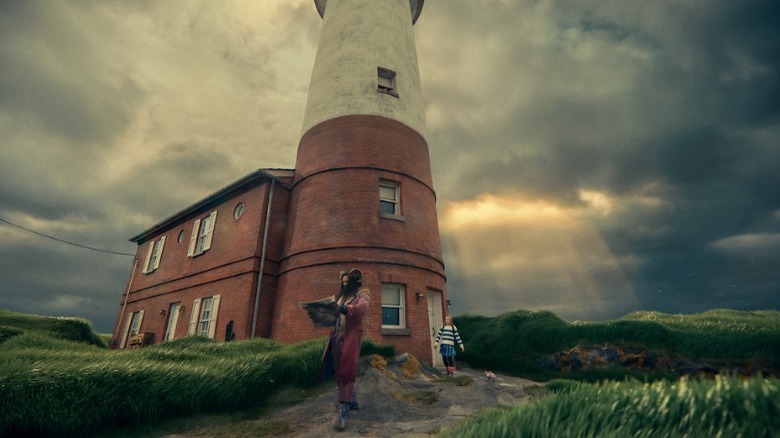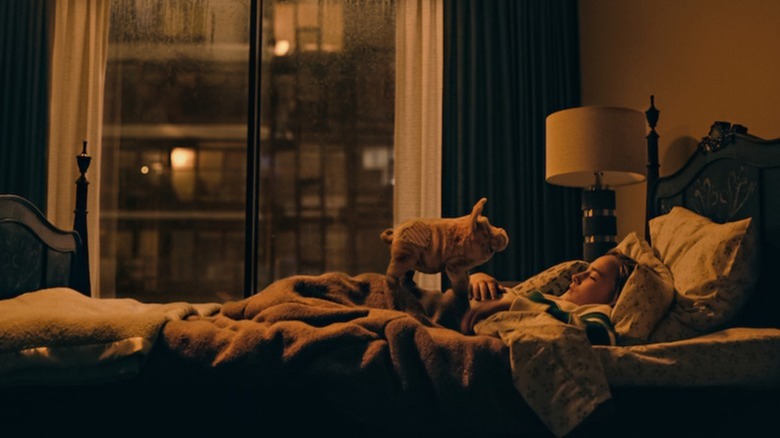The Ending Of Slumberland Explained
Where do we go when we dream? This question has fascinated humanity for centuries, and with good reason. While our bodies lay motionless, our minds go to a place where the laws of physics don't apply, logic and continuity don't hold up, and everything feels somehow meaningful and important. Dreams have inspired many classic movies, songs, video games, and all manner of other creations. This panoply of sleep-centric stories includes Winsor McCay's classic 1905 comic strip "Little Nemo in Slumberland," which is the inspiration for Netflix's "Slumberland." This film is anything but a carbon copy, however: Other than some character names and a scene where a bed grows long legs, "Slumberland" tells its own unique story.
That story is primarily about grief, as plucky heroine Nemo (Marlow Barkley) spends most of the movie retreating into her dreams to process the recent death of her father, Peter (Kyle Chandler). But just like dreams themselves, "Slumberland" also contains deeper messages regarding identity and the role of the subconscious in our sleeping and waking lives. This results in some genuinely tear-jerking moments alongside colorful and family-friendly action, and a fascinatingly complex ending. If you've seen it, you might be a bit confused as to which elements of its conclusion are real, which are ephemeral, and what it all means. We're here to help. This is the ending of "Slumberland," explained.
Flip and Philip
"Slumberland" seems like a simple story, at first: Nemo escapes to her dreams to avoid her grief over her father's death. In Slumberland she meets Flip (Jason Momoa), a wild outlaw figure, and embarks on a quest to find mythical magic pearls that grant wishes. In addition to outrunning her sorrow, Nemo's nighttime journeys also allow her to avoid the clumsy bonding attempts of bumbling uncle Philip, her new guardian.
Cleverly,"Slumberland" doesn't reveal this uncle's name until halfway through the movie. This throws viewers off the scent, allowing the revelation that Flip and Philip are two halves of the same person to land with appropriate poignance. Flip is Philip's persona in Slumberland, the dream realm where he used to travel with Nemo's father, Peter. When Peter left home to get married and have waking adventures, Philip split himself in two in a fit of abandonment-spurred psychosis, going without sleep for three days. Ever since this climactic moment, he hasn't been able to remember his dreams. In Slumberland, Flip has become stranded, and forgotten who he is in the waking world. Fortunately, rather than having "Fight Club"-style irreconcilable differences, the two halves of "Flilip" are reunited when Nemo uses her magic pearl to wake Flip up. In this moment, Philip regains his dormant sense of adventure and rescues Nemo from the sea.
Bravery in the face of grief
The climax of "Slumberland" elegantly brings all the strands of the story together. At long last, with Flip's help, Nemo manages to get hold of a magic pearl. She is mere steps away from the lighthouse, where she can wish for an eternal dream of her father and never have to let him go. But Nemo ultimately chooses to save Flip from the nightmare squid and wake him up. In so doing, she chooses to let her father go and face an unknown future.
This is exactly the kind of bravery that Agent Green (Weruche Opia) talks about at the Bureau of Subconscious Activities. As predicted, the instant Nemo makes the decision to let go of what she's already lost, the squid vanishes. It isn't that she stops grieving. As Agent Green rightfully points out, being brave isn't about a lack of fear or pain — it's about moving on in spite of it. This is what Nemo chooses to do. Life always moves forward, even in the face of impossible sadness. Nemo's decision reflects her acceptance of this eternal fact — and the hope that goes with it.
A final farewell
"Slumberland" might see Nemo make a tough decision regarding her father's memory, but it also lets her have her cake and eat it too by rewarding her with a final paternal goodbye. As fans of Kyle Chandler know well, you simply don't cast the actor as a dad and not have him say emotional stuff at the end of the movie. After Nemo gives up her plan to recreate her dad in the world of dreams, Agent Green coyly reveals that the girl's trusty companion Pig has actually scooped up two pearls from the Sea of Nightmares. In a valiant effort to join the list of movies guaranteed to make you cry, "Slumberland" uses this revelation to enable a final farewell between father and daughter.
Peter imparts a number of poignant truths to Nemo in this scene, chief among them the fact that she needs to embrace her waking life and its myriad possibilities. It's truly cathartic and gratifying to see the characters reconnect, especially after Nemo proves herself willing to let go of the idea in the first place. It might be a little indulgent, but "Slumberland" gets away with it by virtue of its ramshackle charm and killer cast.
With friends like these
One of the best aspects of "Slumberland" is that it doesn't feel the need to manufacture conflict between its characters. Nemo is struggling with grief and change; the nightmarish squid that represents these feelings is the only villain that the movie needs. This allows Nemo's friendship with Jamal (Chris D'Silva), a kid at her new school, to flourish. Their bond isn't a critically important part of the plot, but his actions do play a key part in Nemo's journey.
At first, it seems like Jamal might become a companion in Nemo's adventures in some way, since they seem like equally strange misfits. But eventually it becomes clear that Jamal's only contribution to the plot is the moment he betrays Nemo's trust and brings guidance counselor Miss Arya (India de Beaufort) to the basement, to see where Nemo's been ducking class. At first, he seems to admire Nemo for pretending to be on a trip, but when he learns that her father recently died, he realizes that her behavior might not be healthy. Sometimes, friendship means breaking someone's confidence. Thankfully, Nemo seems to understand this: She doesn't seem angry at Jamal in the moment, and clearly bears no grudges, as they're seen to be good friends at the end of "Slumberland."
The double knock and the outlaw code
As so many heroes of the silver screen make clear, a man's got to have a code. The use of the "outlaw code" at various points in "Slumberland" initially seems like a plot device to rope Flip into helping Nemo on her quest. But gradually, it becomes a way to get at the emotional underpinnings of the story. The idea that a "double knock" invokes a sacred bond between outlaws is first indicated by Peter, as part of his fairy-tale-like bedtime stories. But we soon learn that there's nothing fictitious about these unbreakable ties. Peter, as it turns out, was forced to ignore a double knock from his brother Philip, who was trying to make him promise not to go away.
The childish outlaw values of Slumberland can't stop time, of course. Eventually, families evolve and change, and distance grows between even the most tightly bound people. Later, Flip goes back on his own double knock bond with Nemo, abandoning her to cross the Sea of Nightmares on her own. It means more, then, that he ultimately chooses to return. He's willing to lose his identity and become Philip again in order to help Nemo with her quest. Life, in practice, is about choices, not codes.
Life's many prisons
Fairy tale though it may be, "Slumberland" presents a thorough critique of the isolation of modern life. This state of affairs is partially due to the character's choices. Peter decides to isolate himself from the world after his wife passes away, raising Nemo alone in a remote lighthouse. Although Philip lives in the city, he's arguably even more alone than his brother, without even Nemo to keep him company. But "Slumberland" argues that societal alienation is also baked into the system. Nemo makes this especially clear when she declares, "My dad said schools are basically prisons. They keep kids locked up physically and mentally, prepare them for jobs that are also basically prisons, until they retire and go to a nursing home. Their final prison."
Philip, who works remotely and has no friends, definitely seems to be living in a prison of his own making, apparently proving Peter's point. As Miss Arya hints, it's only by accessing his dormant sense of imagination that he can escape from his dull, mechanical life of doorknobs and locks. If you take Peter's words for it as gospel, this sort of imagination is exactly what modern life wants to stamp out.
You have the dream you're meant to have
While many all-ages movies that tackle the world of dreams and imagination have a fun, "Wizard of Oz"-like enthusiasm for the topic, "Slumberland" actually takes things in a slightly stranger direction. This film implies that dreams are managed by a bureaucracy — one that's got your best interests at heart, granted, but it's still a surreal approach. Agent Green opens the movie with a cryptic indicator of this state of affairs: "Your dreams don't just happen," she intones. "We make them happen. And we design them with care just for you. We have our reasons, and we have our rules. We make your dreams to help you on your journey."
It's not clear if the Bureau of Subconscious Activities is a sub-department of some sort of larger order that runs reality behind the scenes. But its existence sends a very intriguing message about the nature of the subconscious. Your dreams are "designed" to be just what you need in that moment, as random as they may seem. Apparently, quite of few of us need to deal with the concept of having our teeth fall out, showing up naked to class, or taking a test we haven't prepared for. Why? The reasons might be currently unknown to you, but "Slumberland" argues they're well worth figuring out.
Dying in dreams
"Slumberland" ups the dramatic stakes of its story significantly when Flip explains to Nemo that while a dreamer can't die in their own dream — they just wake up — all bets are off when they cross into someone else's nighttime reverie. This sets up something of a bait-and-switch with our dramatic expectations. Although Nemo participates in death-defying acts throughout Slumberland, she never seems like she's in real danger — until she takes a sailboat out in a rainstorm in the waking world, and promptly gets knocked out by the boom (that's the wooden bar at the bottom of the sail, although it's also an onomatopoeia in this case).
This allows the movie to create a strikingly effective climax. As scary as it appears, the danger of Slumberland's nightmare squid is clearly always emotional. But when Nemo finally faces it at the end of the movie, she's also in physical peril in the waking world, especially when the boat runs aground on treacherous rocks. It's the perfect narrative sleight-of-hand: The viewer hasn't thought about the fact that if Nemo dies in real life, she dies in Slumberland, until that becomes a terrifyingly possible prospect.
Where did the map come from?
In its first act, "Slumberland" seems like it's intent on blurring the line between the waking world and the dream world until they're indistinguishable. But eventually, it reasserts the boundary between these realms. It soon becomes clear that Slumberland is more of an allegorical place, where we learn important things about Nemo and Philip and their emotional states. That's a perfectly fine approach to take in a straightforward story about dreams — not everything needs to be as confusing as "Sandman," after all. But if Slumberland isn't "real," where does the map come from?
The map stands out as the only object from Slumberland that pops up in real life. How Peter came by it in the first place is a mystery. Did he transport it into the waking world somehow? Did he re-create it from memory? He certainly seems to have acquired a number of impressive skills, as seen in the opening father-daughter montage. Making intricate maps of Slumberland is apparently among them.
Graciela's dream
As Nemo and Flip end up retracing their steps, we don't get to see many different examples of dream worlds in "Slumberland." We do, however, get an action-packed sequence in the big finale as they run from the squid monster through multiple dreams. Most vividly, we finally learn the identity of the vivacious dancer Graciela (Humberly González), who hails from the dream with all the butterflies.
Flip implies that anyone as exuberant as Graciela must be repressed in the waking world. The movie's conclusion confirms this theory when it reveals that the real-world Graciela is, in fact, a Catholic nun. As a kicker, she's also apparently asleep during Mass, a scandal in and of itself. "Slumberland" argues that people have the dreams they're meant to have. What does that say about Graciela? We can only speculate, but it definitely seems like she's on one heck of an internal journey.
A lighthouse's purpose
What is a lighthouse for? This question, posed by Peter to his daughter, bookends "Slumberland." A lighthouse isn't simply to keep ships safe, as Nemo answers at the start. Ultimately, like dreams themselves, a lighthouse acts as a guide to weary travelers. While that might make the query seem like a frustrating trick question — Nemo is still technically right — it's not quite that simple. Like many aspects of "Slumberland," this question deftly gets at the larger themes in play.
Both Peter and Nemo associate the lighthouse with safety — the kind it offers ships, and the kind it offers a widower with a child to raise. But even though Nemo has her heart set on taking over the lighthouse one day, Peter knows she's destined for bigger things. Their life together seems idyllic (if a little lonely), but it's just one life among many. Peter knows it should only be a stop along the way for his daughter, rather than a final destination. As her father, he's the keeper of the light, which allows her to discern a future he can only dream of. And there are no greater dreams than the ones that parents carry for their children. The purpose of a lighthouse and a parent are the same: To guide wayfarers on their route to adventure, safety, happiness, and peace.
Life is what happens when you're awake
Both Nemo and Philip have reasons to hide in dreams. Nemo retreats to Slumberland out of intense loss and a desperation to hold onto her old life. Philip, nursing an old wound, doesn't even realize that an entire aspect of himself has hidden in Slumberland and refuses to come out. But once he's reawakened the Flip-side of his personality, he stops retreating inward and becomes the more boisterous person that his brother once knew. Instead of relying on lists to make small talk, he connects to his niece emotionally (and with a piece of yarn, for dream purposes).
Neither character decides to shun the waking world or Slumberland, which holds more appeal than ever. Instead of seeking out the lighthouse or her father, Nemo tells Philip that she's simply going to venture forth into the unknown. Her dreams will take her where they may — as, of course, will her waking life. Philip understands the wisdom of this. As he puts it, life may be what happens when we're awake, but dreams are what tie us together. Every night, our minds wander, stretching the boundaries of what we know to be real. We return to the waking world refreshed, and more ourselves than ever. Accepting the duality of this is key to both characters' growth.
